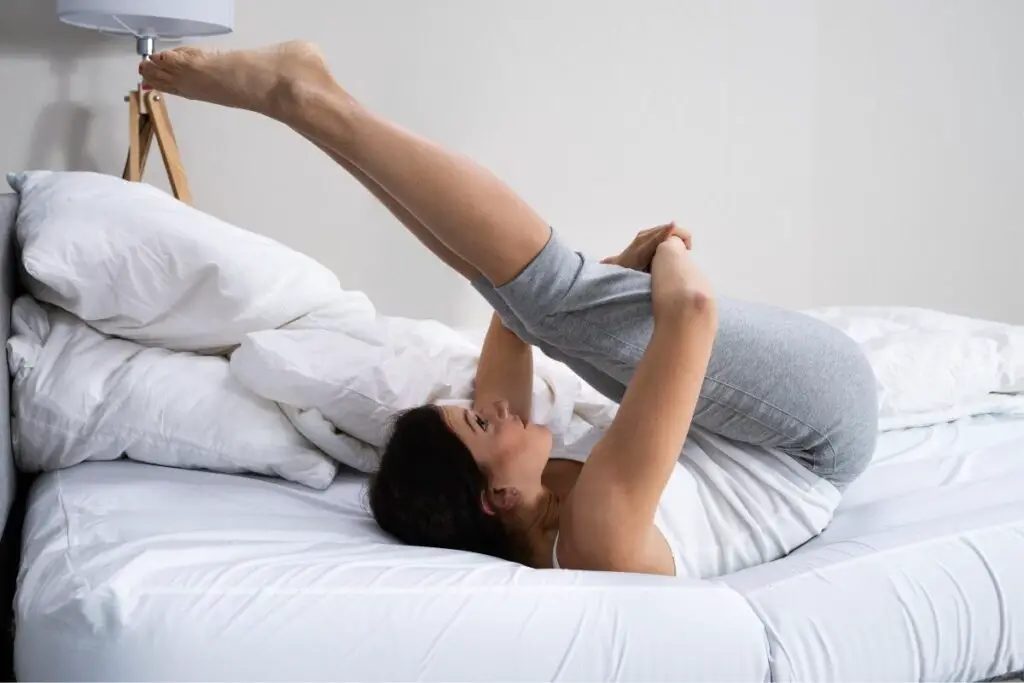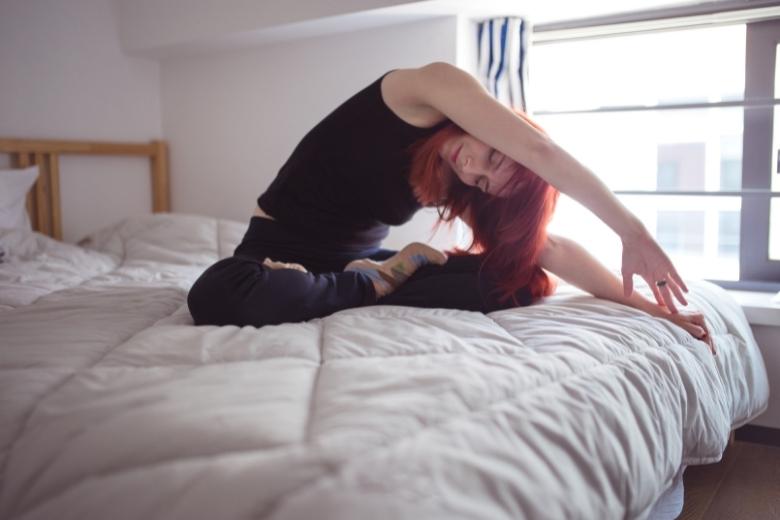There are a lot of great exercises that can be done off of the floor, but there are also bed exercises for those with mobility challenges. Anytime somebody begins to search online for the best exercises they can do at home, oftentimes the results require that the individual get down on the floor to perform them. Floor exercises are fine for a younger person, but the very act of getting down onto and up off of the floor can be incredibly difficult for a senior.
It’s not that there’s anything wrong with those floor exercises. Pushups and all are great, it’s just that if a senior is going to be working out at home, they need things to be as convenient as possible for them. Seniors are already at an increased risk of falling compared to the rest of the population, so they should also be doing balance exercises, and the chances of their falling as they attempt to climb their way back up into a standing position are going to be increased.
So why not do what we can to minimize that risk through balance exercises and leg exercises? If we can combine all of the benefit of working out at home while simultaneously minimizing the risk, then we have a recipe for success, do we not? This is where bed exercises come into play.
Below are some of the exercises I regularly had my clients perform from the comfort of their own bed.
Disclaimer: It’s important to get a doctor’s approval before starting any exercise program. The below is for informational purposes only. I’m not prescribing these exercises to you; I’m just telling you what I did for clients in the past. Sometimes there are personal health reasons that keep people from being able to perform a particular exercise.
If you’re going to start a new workout routine, you’re going to want to make sure you’re not going to start doing something that will hurt you. This is where finding your own personal trainer (not me) and asking for their advice is beneficial.
Pelvic Tilts
One of my mentors when I first started personal training instructed me that this was something that every post-menopausal woman needed to perform. As women age, the muscles of their pelvic floor weaken. It doesn’t even necessarily have to be a problem that is solely age-related either. Pregnancies can cause issues with the muscles of the pelvic floor as well. Incontinence can be one of the end results here.
Performing pelvic tilts helps to strengthen those muscles of the pelvic floor to fight back.
All one has to do here is to lay on their back, bend the knees, and then tilt the pelvis. This sounds weird, but it’s not as difficult to do as it sounds. When somebody lays on their back, there’s automatically going to be a bit of a curve where the lower back is. I would have somebody try to flatten out their lower back to touch the ground – causing their pelvis to tilt. Typically, I would have somebody do two sets of 20-30 repetitions of this one.
You can see a visual representation of what pelvic tilts look like below:
Bridges
I think these are one of the best exercises that a senior can do to help to strengthen their butt and hamstrings (part of what personal trainer jargon refers to as “the posterior chain”). These exercises are great. Just about anybody can do them. When I had people who had knee pain that made it so that squats were contraindicated (aka, squats = big no-no in that individual), I could something like 99% of these clients to perform bridges without any pain in the knees whatsoever and they would still be working to build up their legs.
To do these, I would have the client lay on the floor with both of their knees bent. They would then push their butt up into the air, flexing their butt through the entire movement, and then coming back down. I would typically give 2-3 sets of 15-30 repetitions here.
If somebody felt this exercise in their lower back it was because they weren’t flexing their butt. The way I fixed this was by having them go up to the top position and then hold the position, flexing their butt as hard as they could for five seconds. This would typically teach people how to mentally “tune in” to flexing their butt for the exercise.
I don’t think it’s as easy to perform bridges in a bed as it is on the floor, but I did have plenty of clients who would perform these in bed at home when they couldn’t make it to the gym.
Seated Straight Leg Raises
This is a good way for people with knee pain to help to build up the front of their thigh without hurting themselves. Just like with bridges, it was incredibly rare for one of my knee pain clients to have knee pain when doing this exercise. If it did hurt (again, rare) then we did something else. Pain in the gym is not something to work through. You only end up hurting yourself when you do that.
To do this exercise, clients would sit up against a wall, or, in this case, the headboard. Typi9cally, they would have pillows behind their back. At the gym, I had a triangle shaped pillow clients could use. Regular pillows will work just fine.
Both legs are stretched out in front of the client and then they would use their leg muscle to lift their right leg straight up from the floor with the knee straight. It’s a straight leg raise, after all. Normally, people can only lift their heel off the floor an inch or two. It depends on your flexibility/strength levels.
The client would do this 2-3 sets of 10-15 repetitions normally. No, I never had people alternate their legs. People look silly when they alternate their legs on this exercise. We always hit the right leg first, completing its set before moving onto the left leg. The exercise targets the front of the thigh and the hip flexors.
Single Leg Raises
This is pretty much the same as a seated straight leg raise. The only difference here is that you’re going to be laying flat on your back with one knee bent and the other leg straight out, laying flat. The straight leg is the one we work on first.
The client would use their leg muscles to pick that leg straight up into the air as high up as they could get it before letting it go back down (in a controlled descent. Don’t just your leg slam into the floor.). Then, repeat.
Typically, I would have clients perform this exercise for 2-3 sets with 10-20 reps. This one’s just an alternative to the seated straight leg raise that essentially works the same muscles but is easier to perform.
Clamshells
This exercise looks like you’re sleeping on your side. The hips and knees are bent, so someone is almost laying in the fetal position. Then, they keep their feet glued together and open up their knees like a clam. So, as one knee continues to point to the wall the person is facing, the other knee is lifted up so that it points to the ceiling.
This exercise works the butt and is a good way to get somebody that can’t do a lot of other leg exercises (e.g., knee pain) to still be able to work that part of their body. That’s one of the things I try to drive into peoples’ minds in the gym. Just about everybody has some type of injury. But thankfully, there are often “hacks” that we can use to work around an injury.
Need to work your glutes but an old knee injury keeps you from doing deadlifts and squats? We can typically work around that injury by performing clamshells. Pretty cool.
Side Lying Hip Abductions
Do you remember those old exercise videos in the 80s and 90s where women in neon colored gym outfits would lead an at-home exercise class? This is the exercise that those ladies were doing on just about every single one of the covers of those VHS tapes.
They’re laying on their side with one leg pointed up in the air. This is just a more difficult version of the clamshells. You’re still laying on your side, and you’re still working on the glutes, but the leg is straight out instead of bent this time.
I always liked high repetition work for this one, typically prescribing 2-3 sets of 20-30 repetitions here.
Seated Knee Raises
Not all bed exercises have to be done while laying down. You can still use your bed for seated exercises as well. Here is one of the ones I had a lot of clients do. Seated on the edge of the bed with both of their feet on the floor, I would have them pick up one knee at a time. Don’t alternate legs. You don’t need to look like a goofy, marching band member here.
Just work the right leg completely, and then hit the other leg.
This exercise works the front of the thigh and the hip flexors (the muscles that allow you to raise your thigh up parallel with the ground).
I typically had people do 2-3 sets here of 10-20 repetitions.
The guy in the above video shows how to do this with an ankle weight as well. That’s a fine progression here if just doing bodyweight is too easy. A lot of times, I would just give somebody a dumbbell to hold on the top of their thigh while they were doing this one too.
Are There Other Bed Exercises?
Yeah, this isn’t going to be an exhaustive list. There are so many exercises out there, and so many variations of those exercises, that it would be just about impossible to list them all. But these are the main ones that I would have clients perform on a regular basis, and they not only got good results out of them, but they would actually perform them as well. That in and of itself is an entire accomplishment.
Like many other aspects of our lives, the more convenient you can make something, the more likely it is that the person will engage in it. Unfortunately, going to the gym and working out are often considered to be inconvenient, and so the person who really needs to be working out won’t go. It takes them too much mental effort to get into the car and go over to the gym.
But everybody has a bed and it’s a place where they spend a lot of time. Just by telling people that there are such a thing as bed exercises, we help to eliminate one more excuse that people have for not going to the gym and for not working out. By incorporating bed exercises into one’s morning routine, we help to make working out as convenient as possible. You literally don’t have to go anywhere. All you have to do is wake up and lay in bed.
Just about anybody can do that.
It’s for this reason that bed exercises can be a great way for somebody to help to improve their health. There’s no fear about looking silly in the gym, no fear about not being able to get up off the ground, and no hassle with having to get into a car and fight traffic at the end of an already stressful day.
Bed exercises meet a client where they are at, helping to give them the strength they need to live with less pain and live healthier, stronger lives. What are your thoughts on bed exercises? Have you ever utilized any of the above? Are there others you regularly perform that we didn’t list above? Let us know what you’re thinking in the comments below.


